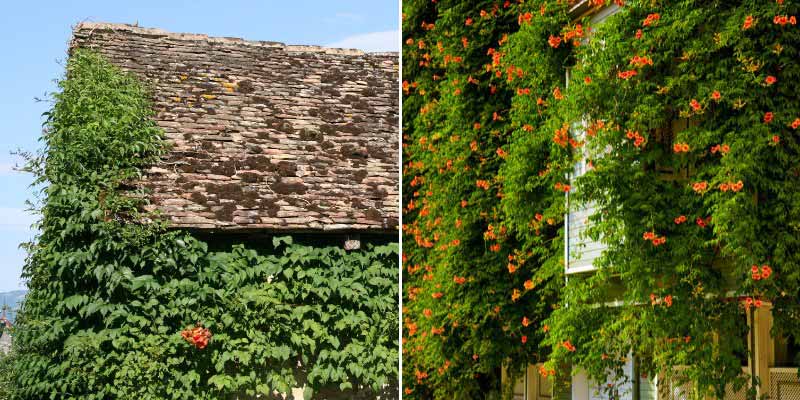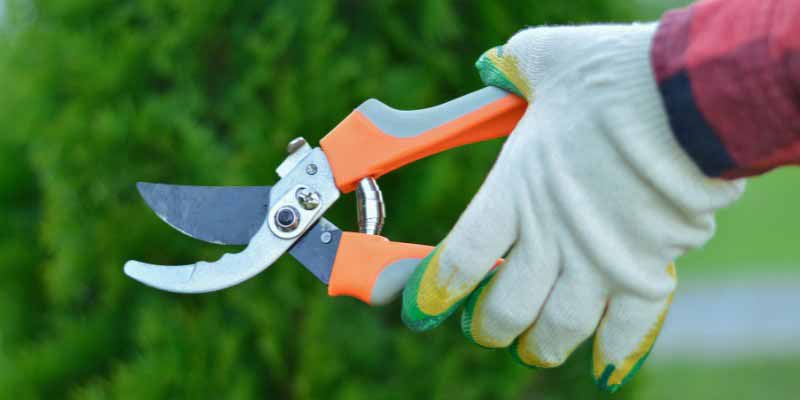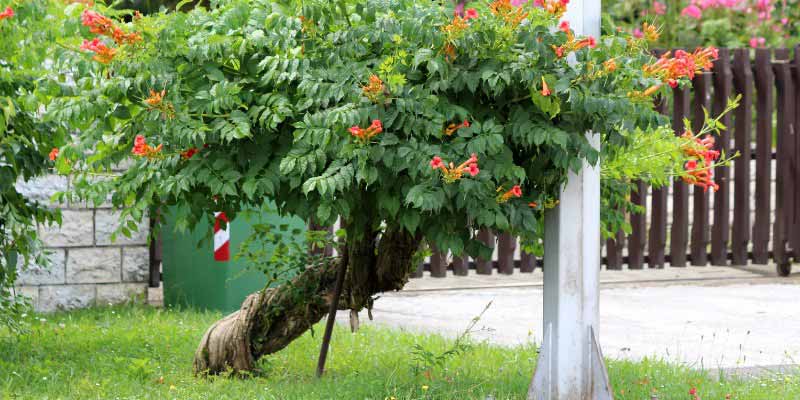The Trumpet Creeper or Campsis is an original and vigorous climbing plant with its magnificent orange trumpet-shaped flowers, which can quickly become invasive if not controlled. Although pruning the trumpet creeper is not essential, it is important to manage its growth, encourage abundant flowering, and maintain a harmonious shape. Discover when and how to prune your trumpet creeper to keep it healthy and well-ordered!
Trumpet Creeper: Characteristics and Growing Tips
The Trumpet Creeper is a beautiful, vigorous liana with exotic charm, native to North America! It is prized for its striking and abundant flowering, ranging from bright orange to fiery red, from July to October-November. It can reach 10 metres in height, or even more, thanks to its aerial climbing roots. Its growth is rapid, growing quickly, up to 1 metre per year. It is ideal for covering walls, pergolas, or creating a dense green screen. Easy to grow in mild climates (it only fears severe frosts and can withstand temperatures down to -10°C), it prefers full sun and well-drained, rich, and moist soil for optimal growth. It is an excellent liana for a Mediterranean or coastal garden.

Why Prune the Trumpet Creeper?
Pruning the trumpet creeper is not essential, but it can quickly become necessary if your plant becomes too invasive. It is a vigorous liana with rapid growth that can quickly colonise walls, pergolas, or fences if left unchecked. Pruning helps contain this exuberant growth and keep the trumpet creeper under control. In addition to limiting its spread, pruning helps maintain a compact and balanced shape, preventing the plant from sprawling disorderly or becoming bare at the base. It is also an excellent way to stimulate the growth of new, more vigorous shoots and encourage abundant flowering. Without pruning, the trumpet creeper will produce few flowers, as cutting stimulates its floral regeneration.

When to Prune the Trumpet Creeper?
The ideal time to prune the trumpet creeper is every year, in late winter, between February and March, just before the growing season resumes. This allows the plant to focus its energy on new shoots in spring. Annual pruning will also prevent the plant from becoming bare at the base. Avoid pruning after March, as the trumpet creeper enters its active growth period. Pruning too late could weaken the new shoots. In August-September, simply remove faded flowers and spent stems. Avoid pruning in autumn: it might not flower at all!
How to Prune the Trumpet Creeper?
Required Tools
- A clean and sharp pruning shear
- Gardening gloves to protect your hands from potential irritation, as the sap of the trumpet creeper is irritating
The trumpet creeper tolerates pruning very well, and the more severe the pruning, the more vigorous and floriferous the plant will be. Indeed, drastic pruning stimulates the production of new shoots and encourages abundant flowering. When you observe branches drying out on their upper third (a completely normal phenomenon), it’s a sign that it’s time to prune.

Steps to Prune Your Trumpet Creeper Properly:
- Remove dry tips, especially those damaged by frost.
- Cut back crossed branches, those that are too thin (slender) or dead at their base, keeping only the most vigorous stems.
- Trim back the previous year's shoots:
- Prune them to about 3 to 4 buds from the main stem, approximately 40 cm. Ensure you always leave a few healthy buds on each branch to guarantee quick regrowth.
- Perform severe pruning if necessary: If the trumpet creeper is too invasive, you can cut it back severely to 30 cm from the ground. It will regrow vigorously!
Pruning the Trumpet Creeper into a Tree Shape
Some trumpet creepers (Podranea ricasoliana) can be trained into a tree shape, an especially interesting option for container cultivation. Here’s how to proceed:
- Select the most vigorous stem and tie it to a sturdy stake to give it good vertical support.
- Remove suckers at the base to maintain a clean main trunk and prevent the trumpet creeper from regrowing as a bush.
- Cut back secondary branches on the lower part of the trunk to the desired height to form a slender trunk.
- Prune the lateral branches to achieve a well-proportioned and harmonious crown.
- Ensure the foliage at the top remains light to allow light to penetrate the heart of the tree, promoting better flowering.
- → Learn more about pruning the trumpet creeper into a tree shape.

How to Care for a Trumpet Creeper After Pruning?
- Give your trumpet creeper a little boost by adding some compost or organic fertiliser at the base to stimulate vigorous regrowth.
- Mulch the base to protect the roots from late frosts.
































Comments